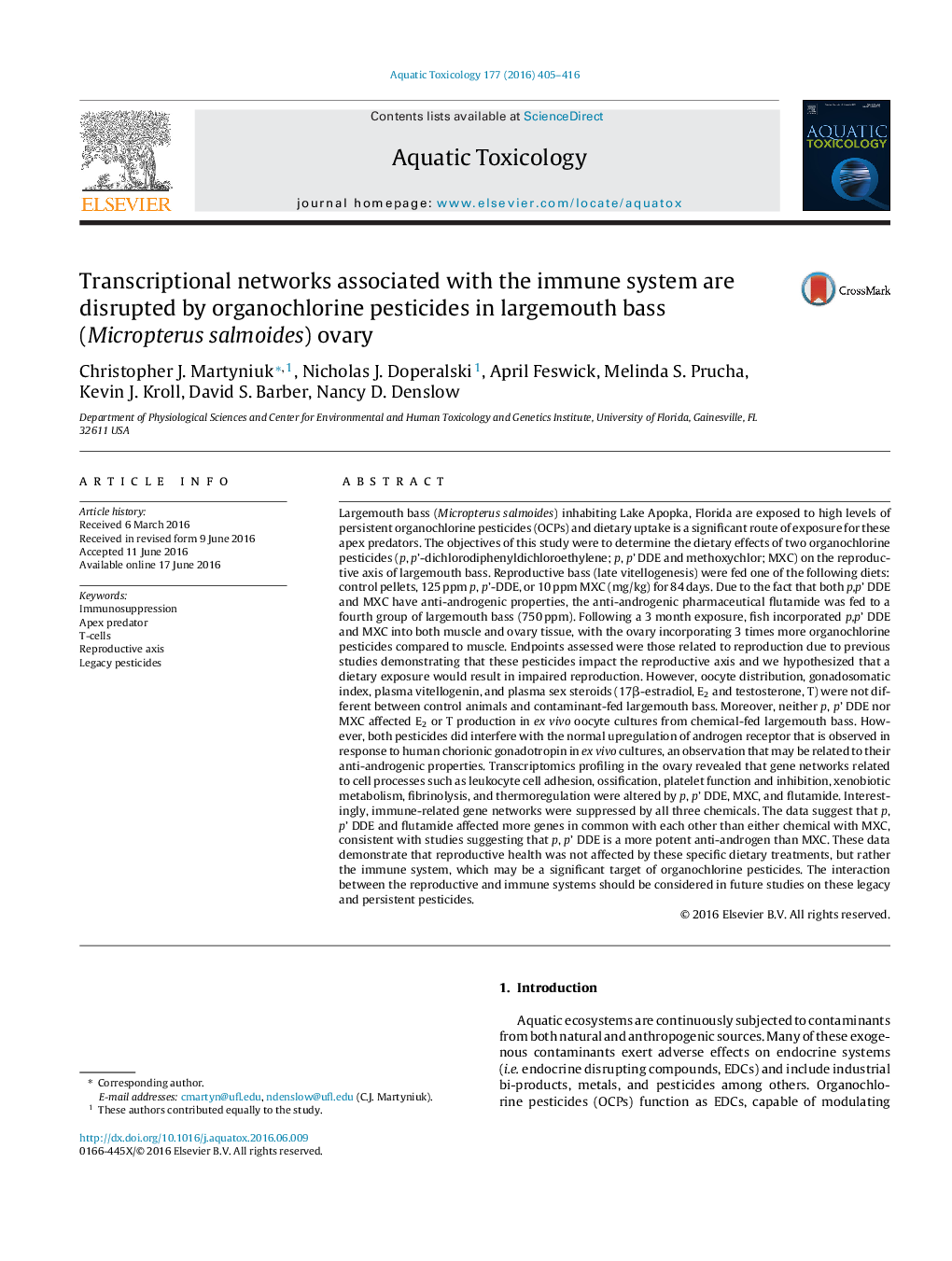| کد مقاله | کد نشریه | سال انتشار | مقاله انگلیسی | نسخه تمام متن |
|---|---|---|---|---|
| 6382044 | 1625928 | 2016 | 12 صفحه PDF | دانلود رایگان |

- Female largemouth bass were fed p,p' DDE, methoxychlor, and flutamide for three months.
- These OCPs and flutamide can act to antagonize the androgen receptor.
- The ovary accumulated three times more contaminant than the muscle.
- Reproductive endpoints, such as oocyte development, plasma steroids and vitellogenin were not altered.
- Gene network analysis suggested that the immune system may be a major target for OCPs.
Largemouth bass (Micropterus salmoides) inhabiting Lake Apopka, Florida are exposed to high levels of persistent organochlorine pesticides (OCPs) and dietary uptake is a significant route of exposure for these apex predators. The objectives of this study were to determine the dietary effects of two organochlorine pesticides (p, p'-dichlorodiphenyldichloroethylene; p, p' DDE and methoxychlor; MXC) on the reproductive axis of largemouth bass. Reproductive bass (late vitellogenesis) were fed one of the following diets: control pellets, 125 ppm p, p'-DDE, or 10 ppm MXC (mg/kg) for 84 days. Due to the fact that both p,p' DDE and MXC have anti-androgenic properties, the anti-androgenic pharmaceutical flutamide was fed to a fourth group of largemouth bass (750 ppm). Following a 3 month exposure, fish incorporated p,p' DDE and MXC into both muscle and ovary tissue, with the ovary incorporating 3 times more organochlorine pesticides compared to muscle. Endpoints assessed were those related to reproduction due to previous studies demonstrating that these pesticides impact the reproductive axis and we hypothesized that a dietary exposure would result in impaired reproduction. However, oocyte distribution, gonadosomatic index, plasma vitellogenin, and plasma sex steroids (17β-estradiol, E2 and testosterone, T) were not different between control animals and contaminant-fed largemouth bass. Moreover, neither p, p' DDE nor MXC affected E2 or T production in ex vivo oocyte cultures from chemical-fed largemouth bass. However, both pesticides did interfere with the normal upregulation of androgen receptor that is observed in response to human chorionic gonadotropin in ex vivo cultures, an observation that may be related to their anti-androgenic properties. Transcriptomics profiling in the ovary revealed that gene networks related to cell processes such as leukocyte cell adhesion, ossification, platelet function and inhibition, xenobiotic metabolism, fibrinolysis, and thermoregulation were altered by p, p' DDE, MXC, and flutamide. Interestingly, immune-related gene networks were suppressed by all three chemicals. The data suggest that p, p' DDE and flutamide affected more genes in common with each other than either chemical with MXC, consistent with studies suggesting that p, p' DDE is a more potent anti-androgen than MXC. These data demonstrate that reproductive health was not affected by these specific dietary treatments, but rather the immune system, which may be a significant target of organochlorine pesticides. The interaction between the reproductive and immune systems should be considered in future studies on these legacy and persistent pesticides.
Journal: Aquatic Toxicology - Volume 177, August 2016, Pages 405-416